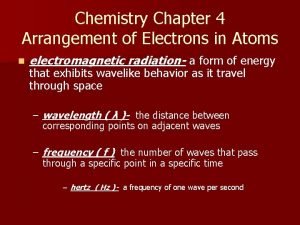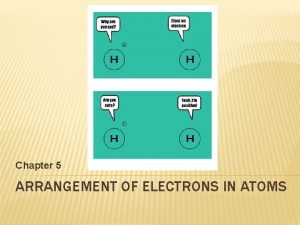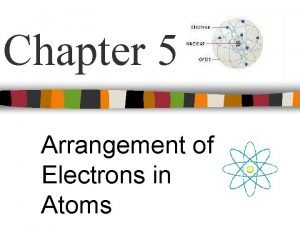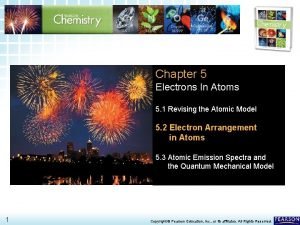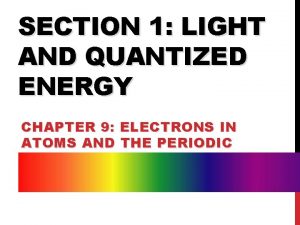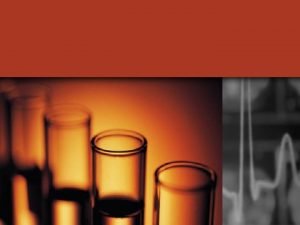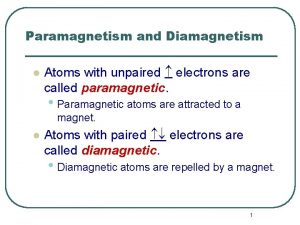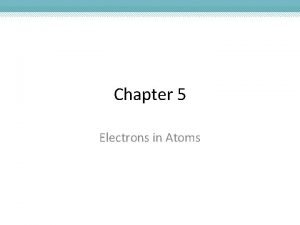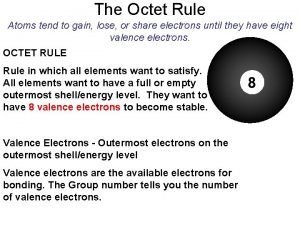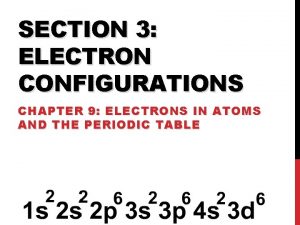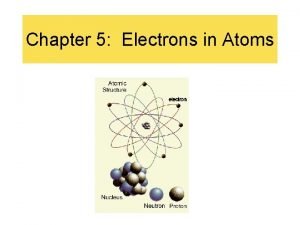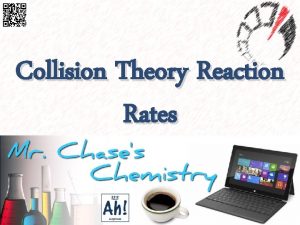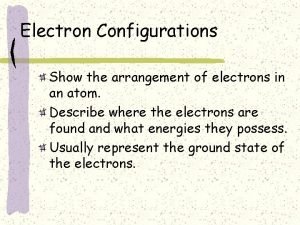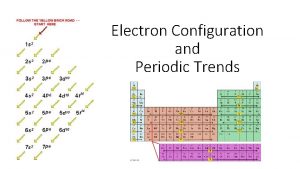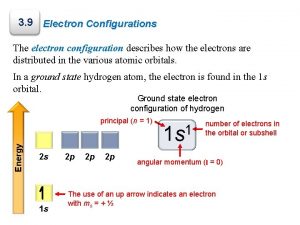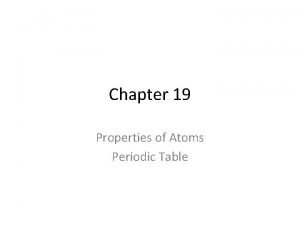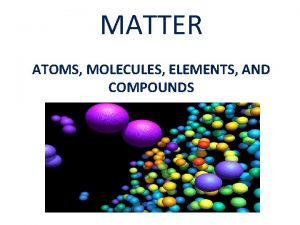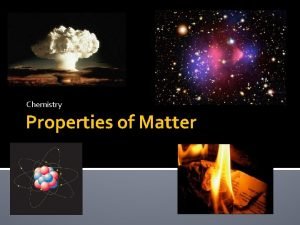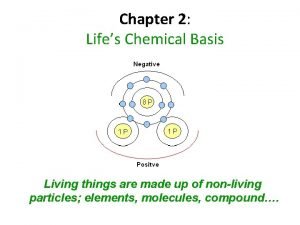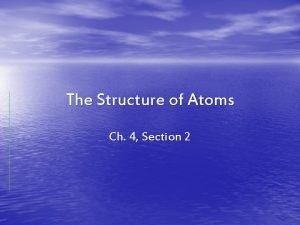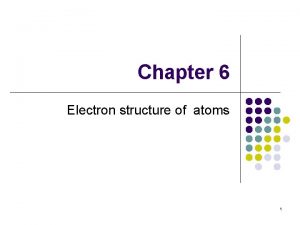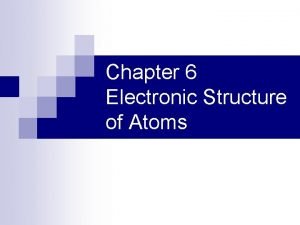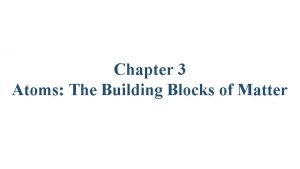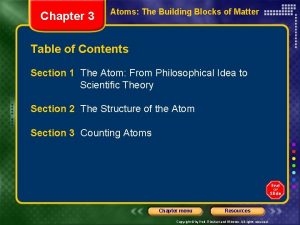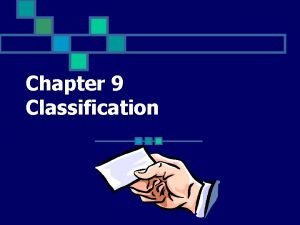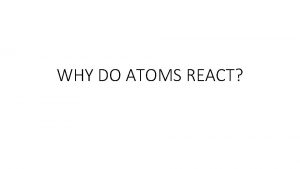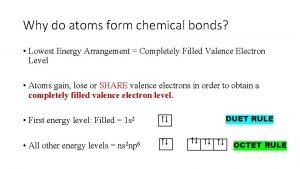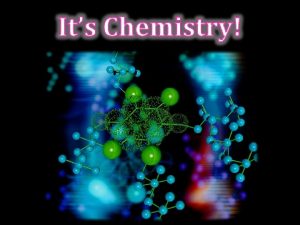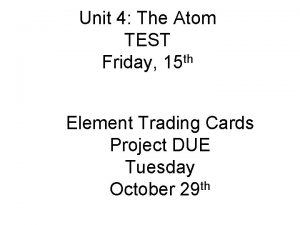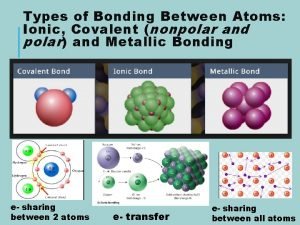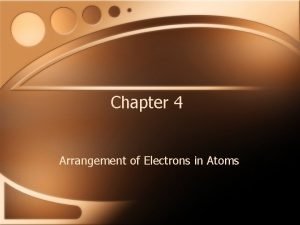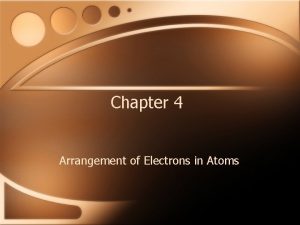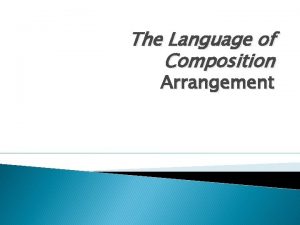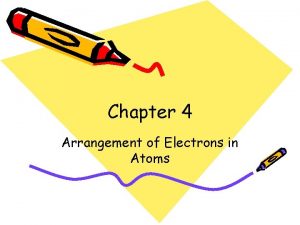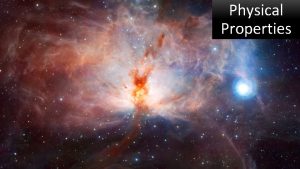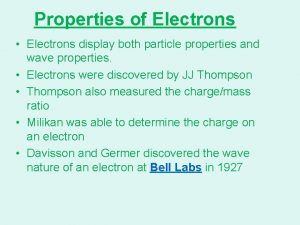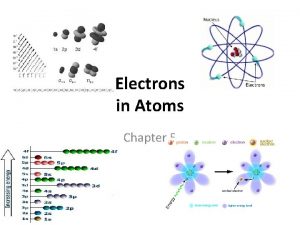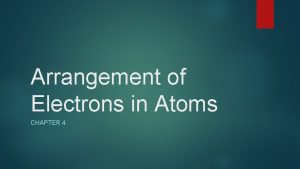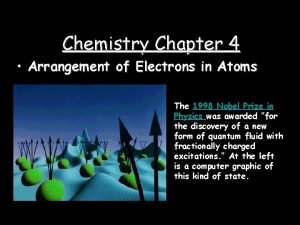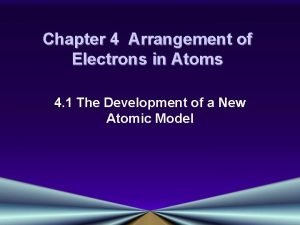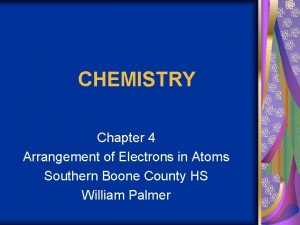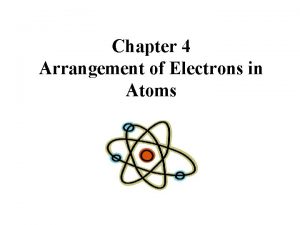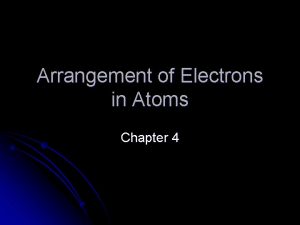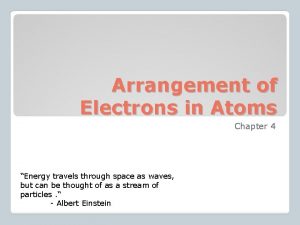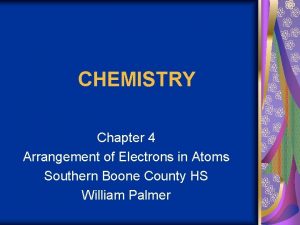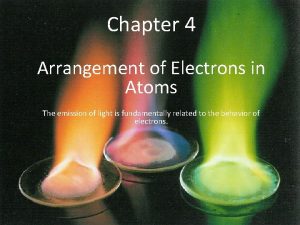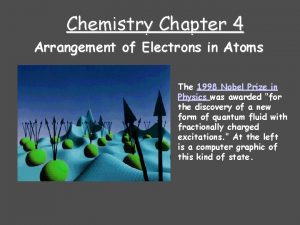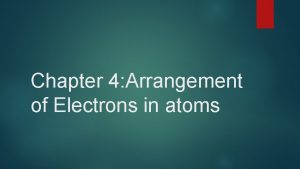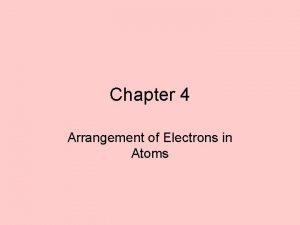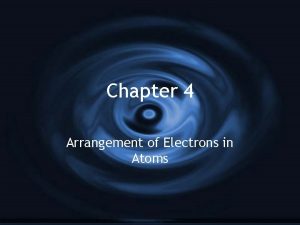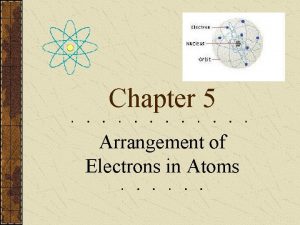CHAPTER 4 Arrangement of Electrons in Atoms PROPERTIES












































- Slides: 44

CHAPTER 4 Arrangement of Electrons in Atoms

PROPERTIES OF LIGHT • The wave description of light • Electromagnetic radiation–a form of energy that exhibits wavelike behavior as it travels through space. • Wavelike behavior—what does this include? ? • Reflection • Refraction • Interference • Together, all forms of electromagnetic radiation form the electromagnetic spectrum.

THE ELECTROMAGNETIC SPECTRUM

• Wavelike behavior = repetitive nature • Wavelength (λ) • Expressed in m or nm. • Frequency(s-1 or Hertz, Hz) —the number of waves that pass a given point in a specific time. Shorter Wavelength = higher frequency Longer wavelength = lower frequency

FREQUENCY AND WAVELENGTH • Mathematically related to each other. • c = λν • c = speed of light (2. 998 × 108 m/s) (constant) • λ = wavelength in meters (m) • ν = frequency in s-1

PRACTICE 1. What is the frequency of green light, which has a wavelength of 4. 90 x 10 -7 m? 2. An X-ray has a wavelength of 1. 15 x 10 -10 m. What is its frequency?

PRACTICE CNTD. 3. What is the speed of an electromagnetic wave that has a frequency of 78 x 106 Hz? 4. A popular radio station broadcasts with a frequency of 94. 7 MHz. What is the wavelength of the broadcast? (1 MHz = 106 Hz)

NUCLEAR ATOM AND UNANSWERED QUESTIONS Rutherford’s nuclear model of the atom was not complete: • Distribution of electrons? • What prevented attraction between nucleus and electrons?

RECALL • A laser emits light of frequency 4. 74 x 1014 s-1. What is the wavelength of the light in m? In nm? • A certain electromagnetic wave has a wavelength of 625 nm. What is the frequency of the wave?

THE PHOTOELECTRIC EFFECT • In the early 1900 s, scientists studied experiments that could not be explained by the wave theory of light. • The photoelectric effect—The emission of electrons from a metal when light shines on the metal. • Light must be at a minimum frequency to knock an electron loose from the metal • If light was wavelike only, any frequency of light would cause a loss of an electron.

RECALL • What is the speed of an electromagnetic wave that has a frequency of 78 x 106 Hz? • A popular radio station broadcasts with a frequency of 94. 7 MHz. What is the wavelength of the broadcast? (1 MHz = 106 Hz)

MAX PLANCK • Studied emission of light by hot objects. • Proposed that hot objects do not emit electromagnetic energy continuously, but in small, specific packets called quanta. • A quantum is the minimum quantity of energy that can be lost or gained by an atom. • E = hν

DUAL WAVE-PARTICLE NATURE OF LIGHT • Light exhibits both wave and particle-like behavior • Each particle carries a quantum of energy • A photon is a particle of electromagnetic radiation having zero mass and carrying a quantum of energy. • Ephoton = hv • Einstein—EM radiation is absorbed by matter only in whole numbers of photons.

CALCULATING THE ENERGY OF A PHOTON What is the energy for the following photon? 1. 05 x 10 -7 m

ATOM EMISSIONS • Ground state—the lowest energy state of an atom • Excited state—A state in which an atom has a higher potential energy than it has in its ground state Photon Different “jumps” of energy provide different frequencies of emission and therefore, produce different colors. Photon

LINE SPECTRA • A prism can separate light into isolated colors. • These separate colors are known as the line emission spectrum of that particular element. • Represents the spectrum of frequencies of EM radiation emitted.





• Three series • Lyman THE HYDROGEN LINE EMISSION SPECTRA • Emission occurs in the ultraviolet region • Balmer • Visible light region • Paschen • Occurs in infrared region

• Wave theory—predicted H to have a continuous spectrum. • Quantum theory was developed to explain the line emission spectra of H. • Since H only emitted specific frequencies of light, the energy differences between energy states must be fixed as well. • Provided the idea for the Bohr model of the atom.

BOHR MODEL OF HYDROGEN ATOM • Niels Bohr model of the atom • Electrons can only circle nucleus in paths or orbits (like planets around the sun) • Each orbit level has a fixed amount of potential energy. • Electrons have higher energy the further away from the nucleus they are. E 3 E 2 E 1 Absorption E 1 Emission

ONE PROBLEM… • Bohr’s model only worked for Hydrogen, a single electron atom. • It did not apply to atoms with more than one electron. • Did not explain the chemical behavior of atoms


SECTION 2 The Quantum Model of an Atom

WHY DO REACTIVITIES OF ATOMS VARY?

ELECTRONS AS WAVES • 1924—Louis de Broglie proposed that electrons also carried dual wave-particle nature. • Suggested that electrons behaved as waves in that they could only exist at specific frequencies. • These frequencies corresponded to the quantized energies of Bohr’s orbits. • How? ? • Combined Planck’s E = hc/λ and E = mc 2. • Suggested that anything with mass and velocity has a λ. • Therefore, electrons behave as waves also.

HEISENBURG UNCERTAINTY PRINCIPLE • If electrons behave as both particles and waves, where are they in the atom? ? • Heisenburg Uncertainty Principle—it is impossible to determine simultaneously both the position and velocity of an electron or any other particle.

SCHRODINGER WAVE EQUATION • Quantization of electron energies was a natural outcome of the equation. • Laid the foundation for quantum theory, which describes the wave properties of electrons mathematically. • Solutions are known as wave functions and give the probability of finding an electron in a given place around the nucleus.

SCHRODINGER CONT. • Proposed that electrons do not travel around the nucleus in neat orbits, such as the planets around the sun. • Electrons exist in regions called orbitals, or a 3 D region around the nucleus that indicates the probable location of an electron.

ATOMIC ORBITALS AND QUANTUM NUMBERS • Quantum numbers—specify the properties of atomic orbitals and the properties of electrons in orbitals • Four numbers: • Principle quantum number—main energy level • Angular momentum—shape or orbital • Magnetic—orientation of orbital • Spin of electron—fundamental spin state of electron


SECTION 3 Electron Configurations

ELECTRON CONFIGURATIONS • What are they? ? • The arrangement of electrons in an atom • All electrons want to be in as low of an energy state as possible (ground-state electron config). • Simple rules allow us to easily determine the electron configs of atoms

RULES GOVERNING ELECTRON CONFIGS • Aufbau principle—an electron occupies the lowest energy orbital that can receive it. • Pauli exclusion principle—no two electrons in the same atom can have the same set of four quantum numbers. • Hund’s rule—orbitals of equal energy are each occupied by one electron before any orbital is occupied by a second electron, and all electrons in singly occupied orbitals must bear the same spin state.




REPRESENTING ELECTRON CONFIGS • Three ways • Orbital Notation—Uses arrows for electrons to show spin states. • Electron-configuration notation—number of electrons in a sublevel is shown as a superscript • Noble gas notation—symbol for noble gas is enclosed in brackets

ORBITAL DIAGRAM PRACTICE • Draw the orbital diagram for fluorine. • Draw the orbital diagram for bromine.

ELECTRON CONFIGURATION PRACTICE • Write the electron configuration for nickel. • Write the electron configuration for lead.

NOBLE GAS NOTATION PRACTICE • Write the noble gas notation for nickel. • Write the noble gas notation for lead.

 Chapter 4 arrangement of electrons in atoms test
Chapter 4 arrangement of electrons in atoms test Chapter 5 arrangement of electrons
Chapter 5 arrangement of electrons Ccechs
Ccechs Chapter 5 arrangement of electrons
Chapter 5 arrangement of electrons Chapter 5 arrangement of electrons
Chapter 5 arrangement of electrons At stp which substance is the best conductor of electricity
At stp which substance is the best conductor of electricity Electrons in atoms section 1 light and quantized energy
Electrons in atoms section 1 light and quantized energy Atoms with 4 valence electrons
Atoms with 4 valence electrons Diamagnetic elements
Diamagnetic elements How to find neutrons on periodic table
How to find neutrons on periodic table Electrons in atoms section 1 light and quantized energy
Electrons in atoms section 1 light and quantized energy Lowest allowable energy state of an atom
Lowest allowable energy state of an atom Electrons in atoms section 2 quantum theory and the atom
Electrons in atoms section 2 quantum theory and the atom Atoms tend to gain lose or share electrons
Atoms tend to gain lose or share electrons How do chemists model the valence electrons of metal atoms?
How do chemists model the valence electrons of metal atoms? 7 ionic and metallic bonding practice problems
7 ionic and metallic bonding practice problems Electrons configurations
Electrons configurations 5 electrons in atoms
5 electrons in atoms Unstable arrangement of atoms
Unstable arrangement of atoms Electronic configuration is arrangement of electrons in
Electronic configuration is arrangement of electrons in Electron configuration chart
Electron configuration chart Electron configuration
Electron configuration Properties of atoms and the periodic table
Properties of atoms and the periodic table Chemical properties of atoms
Chemical properties of atoms Chemical properties of atoms
Chemical properties of atoms Chemical properties of atoms
Chemical properties of atoms Chemical properties of atoms
Chemical properties of atoms Chapter 4 section 2 the structure of atoms
Chapter 4 section 2 the structure of atoms Chapter 6 chemistry in biology
Chapter 6 chemistry in biology Chapter 6 electronic structure of atoms answers
Chapter 6 electronic structure of atoms answers Chapter 6 section 1 atoms elements and compounds
Chapter 6 section 1 atoms elements and compounds Which of the d orbitals most resembles a pz orbital?
Which of the d orbitals most resembles a pz orbital? Chapter 3 atoms the building blocks of matter
Chapter 3 atoms the building blocks of matter Chapter 3 atoms the building blocks of matter
Chapter 3 atoms the building blocks of matter Chapter 2 atoms molecules and ions
Chapter 2 atoms molecules and ions Extensive properties and intensive properties
Extensive properties and intensive properties Chemical properties of citric acid
Chemical properties of citric acid The arrangement chapter 9
The arrangement chapter 9 Atoms want
Atoms want Why do atoms form bonds? *
Why do atoms form bonds? * Relationship between atoms and molecules
Relationship between atoms and molecules What are atoms?
What are atoms? Kesler science the lab room answer key
Kesler science the lab room answer key The atoms family atomic math challenge answer key
The atoms family atomic math challenge answer key Ionic metallic and covalent bonds
Ionic metallic and covalent bonds
